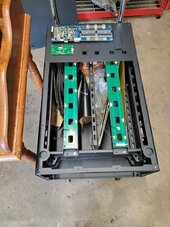Circling back on topic then, DIY 16S harness has 16 sensor/charge wires each need to go to on battery. A ground, and the primary connection thru the relay. A couple of control pins maybe 24 or so pins with RS-422/CAN you have to pin out. Back in the day a CEN50, you soldered down onto the pins and clamped it in maybe 12 wires, 8+4 control if uni-directional. The BMS harnesses are kind of annoying if you need to extend the sensor/bleed wires, but you should be able to get away with some crimp connectors and heat-shrink tubing. The issue with DIY is where to put the BMS. For a 15KWH setup with ~300AH batteries, you may want a 300A BMS, this makes for bigger wires, but interconnect FTA you can probably get away with a pair of #1/0 or something. Now you have to mount this bad-boy on something strong and clamp all the high current bus wires to something strong as well. If you are like some of the guys above with small machine shops, and tools, and can source raw materials easily it's not a problem. If you don't, then you have a tendency to spend quite a bit more than you realize on do-overs and waste. 1/0 is around $4 to 5 per foot. Waste 4 feet, you are out $20. It just adds up when you build it out. Now if you already figured all this out so it would scale, adding additional capacity would get much cheaper, because you know exactly what you need, so if you have the space and can engineer it to scale out, you will benefit greatly if you DIY it. The last part is you are going to want to make sure you decide how you want to communicate with the BMS system(s). Most of them will now talk to the bulk of the larger scale systems, but you are not going to get the integration of say an EG4 AIO with EG4 batteries. Back to the computer analogies, your going to have a custom SCSI card that runs your drives, that might create boot problems if you don't get out in front of it.
Definitely not for everyone.




